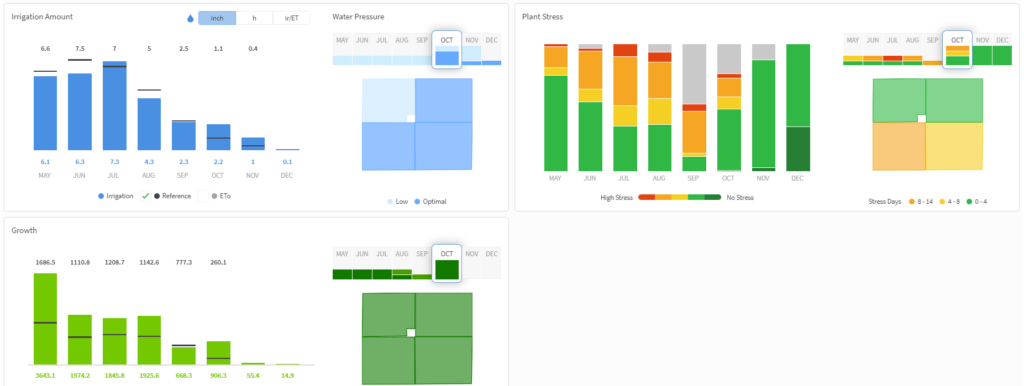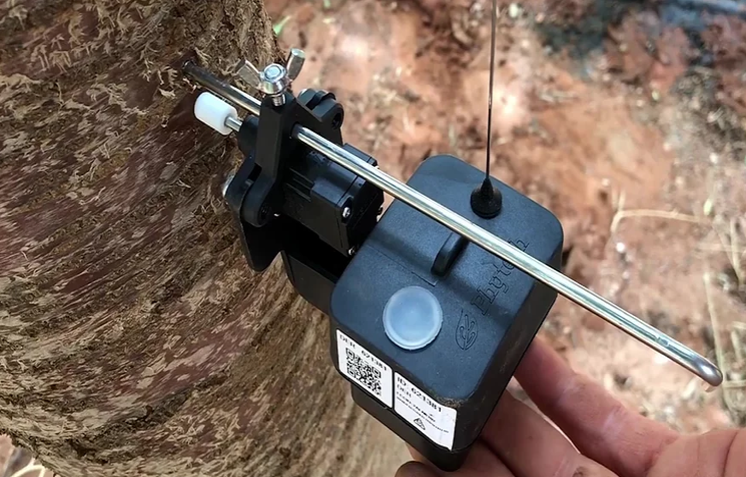EDITOR’S NOTE: This entry is part of an ongoing series to highlight a new technology related to almond and tree nut production. The question/answer format is set to focus more on the technical aspects and application of the technology. I would like to thank Mark Sherfy from Phytech who took the time to answer my questions regarding their irrigation monitoring platform.
Phytech is an irrigation technology that monitors the tree’s water stress. Please describe the basic hardware system and software analysis that is behind Phytech’s irrigation management technology.
Phytech has several different sensors in the field and each sensor has an important role to play in the overall puzzle. We are about understanding exactly what the tree needs and what it is feeling. The ‘bread and butter’ of our organization is our dendrometers, but we also have several other sensors such as water pressure, soil moisture probes, fruit sensors, frost sensors and loggers. By using all these sensors, we can give the grower daily irrigation recommendations and we display an intuitive color scheme that helps the grower understand the current plant status of the orchard. On top of this, we have just launched an analytical section on our website that displays all the season’s data in one area. This displays such things a heat maps, bar and line graphs over different periods of time. Varieties, blocks, and ranches can also be compared to see where adjustments need to be made. It is a tool that gives growers instant recommendations daily, but it’s also an analytical tool that can change the grower’s overall strategy.
What crops have been successful in utilizing Phytech’s products?
Quite a long list of crops. We have been extremely successful in the almond industry as we have found out that the ETc is not only different per orchard, but per variety. We have also determined that managing stress at different times of the season is more critical than other points. I personally used the system and cut back around 15-20% of my water on some second leaf orchards. This is not an exhaustive list but here’s a few of the things we monitor: Pistachios, Walnuts, Pecans, Grapes (Wine/Table), Citrus, Avocados, Blueberries, Corn, Apples, Hemp and the list goes on.
What equipment is installed, and resources that are needed to determine water use?
The main equipment needed for determining water use is the dendrometers. These measure the contraction of the tree/vines in microns as they go through their daily transpiration cycle. This measurement provides insight into what the tree is “feeling” and needing in real-time. From the values obtained from the trunk’s contractions/expansions, coupled with the weather forecast, a daily irrigation requirement can be determined which is provided to the client. Other secondary sensors that help in this analysis are soil moisture probes and water pressure sensors.
What variables are measured?
We measure several different variables. Maximum daily shrinkage, or MDS, is the primary variable used to determine the stress status of the plants. Other variables that are collected are daily growth of the tree, water pressure, water run times, water applied, soil moisture levels, daily fruit growth, cumulative fruit growth, and frost. All these sensors talk to our loggers in the field which relay it back to our data base and to our client’s phones and web applications. Everything is displayed all at one time for a quick assessment of the orchard and this is available both on the web and in the app store. This may sound overwhelming, but we display it in a manner that is actionable and intuitive in nature.

Regarding almond, and from my understanding, the technology is based on the shrink/swell associated with tree water status. This is measured using dendrometers. In the 80’s/90’s, research has shown a strong correlation between dendrometer measurements and stem water potential. What is the difference between Phytech’s analysis and standard dendrometer readings?
First, was our improvement of the dendrometers and their readings. Old technologies provided data that was not accurate enough and varied because of differences in temperature and humidity. Secondly, we had to create a communication technology that was cost effective, can be used within orchards, and did not have any limitations on how many sensors could be placed in the field. Finally, and the most important thing, was to build an algorithm that analyzed and defined the level of stress for the different points of the season. Each crop has its own unique algorithm, and it is a continually learning algorithm. We are constantly discovering new things about each crop and making minor adjustments to better provide for our clients. Take almonds for example; we have come up with our own crop water use curve that is quite a bit different than the ones recommended by the UC.
How does the software determine if the tree is too wet/over-irrigated?
If we see very low activity of expansion/contraction, which is uncorrelated with temperature, and a decrease in trunk growth, we designate that it is an over-irrigated status.
How much hardware is needed to be installed to provide accurate monitoring? For example, if I had a 40-acre block, how many points of measurement are recommended? If the block was 500 acres?
This is the process that we take with new growers:
To begin, we know that growers cannot irrigate every tree individually, so therefore we look to monitor the irrigation for the whole block. We want to keep the block size below 80 acres to maintain statistical validity, and our average size block is around 50 acres. Then we analyze the NDVI, which reflects the soil differences in each block, and pick locations that are representative of that block. If the grower already has a location that he wants in mind (maybe he already has soil probes in a location), then we will obviously place it there.
At that point we begin installation with three dendrometers on three separate trees for data verification. We then install and test all the other sensors.
Specifically for almonds, we can add an additional three dendrometers to measure other varieties, because each variety has different needs and demands.
We also provide the grower the ability to add another dendrometer location in a weaker or stronger area for only 10% of the standard price. This way he can understand why it may be weak and potentially determine a better irrigation strategy for that area or block.
What maintenance is required for the hardware through the season? Since the system requires actual hardware installed on the trees, what are the considerations at harvest?
Phytech is a full-service company that does not sell hardware, so all maintenance is handled by us. Through the season, we will recalibrate sensors, replace broken sensors and batteries, and more. If we come out with a new and better sensor, we will replace it at no extra cost. We don’t believe in giving a grower something and when it becomes obsolete, forcing them to pay for the upgrade. As for harvest considerations all the grower needs to do is notify us two weeks in advance and we will come take the sensors down. Once harvest is done, we will come back and reinstall. Experienced customers can also do the removal and install after harvest themselves if they choose to. It is very simple and straightforward.
What are the unique differences of this system versus an in-situ sap flow sensor, stem water potential measurements, and aerial imagery?
There is a big difference between technologies that measure in real-time and technologies that show a point in time. Tree demand is constantly fluctuating, so making decisions based from a point in time can lead to a suboptimal conclusion. Therefore aerial imagery is not an effective tool for ongoing decision making but is useful for DU issues. Sap flow, from our experience, was problematic in the reliability of constant data flow and did not have the ability to measure trunk growth. Stem water potential readings are good and really reflect the tree feedback that we believe in, but again it is not a continuous real-time reading and requires a lot of labor, potential accuracy issues (as stem water readings change during the day) and it misses out on the trunk growth component.
Within the software, what type of data is available to the farmer for review? What variables are they able to control? Are there features that they can take offline?
All the data captured is available for the farmer to view. We focus on highlighting actionable insights but growers have the ability to research any data that we collect such as – trunk growth rates, MDS, water pressure, water applied, ETc/ETo recommendations, temperatures, fruit size, hours applied, and stress days. They can control most inputs like planting year, variety, application rate, where they want sensors located, how many sites they want. They can also take all these variables and download them as an excel sheet for their own analysis if they desire.
What features of Phytech are often overlooked? Why do these have value?
I believe there are two features that are often overlooked. The first is the amount of data gathered by the system. We have begun to address this by adding in our Dashboard, a feature that allows the grower to see seasons, growth, varieties, and other information all at once. This has great value because if a grower can understand his fields, then he can maximize his production while decreasing costly inputs. The second thing overlooked is our passion for our customers to succeed. At Phytech we not only want the grower to understand the system, but we want them to be successful in all their operations. One of the main reasons I personally loved working with Phytech (and now for them), was that they listened to the growers needs. They didn’t tell me “we don’t do that” but asked me instead “what do you need?” They are constantly improving, constantly learning and have a passion to see every grower succeed.
DISCLAIMER: Please note that the entry is not a recommendation of the product for use. This article contains facts and opinions, and is intended to provide information so that you can learn about new technology that may be of use for your farm. Furthermore, I did not receive any compensation for this article, I simply find the technology interesting.


